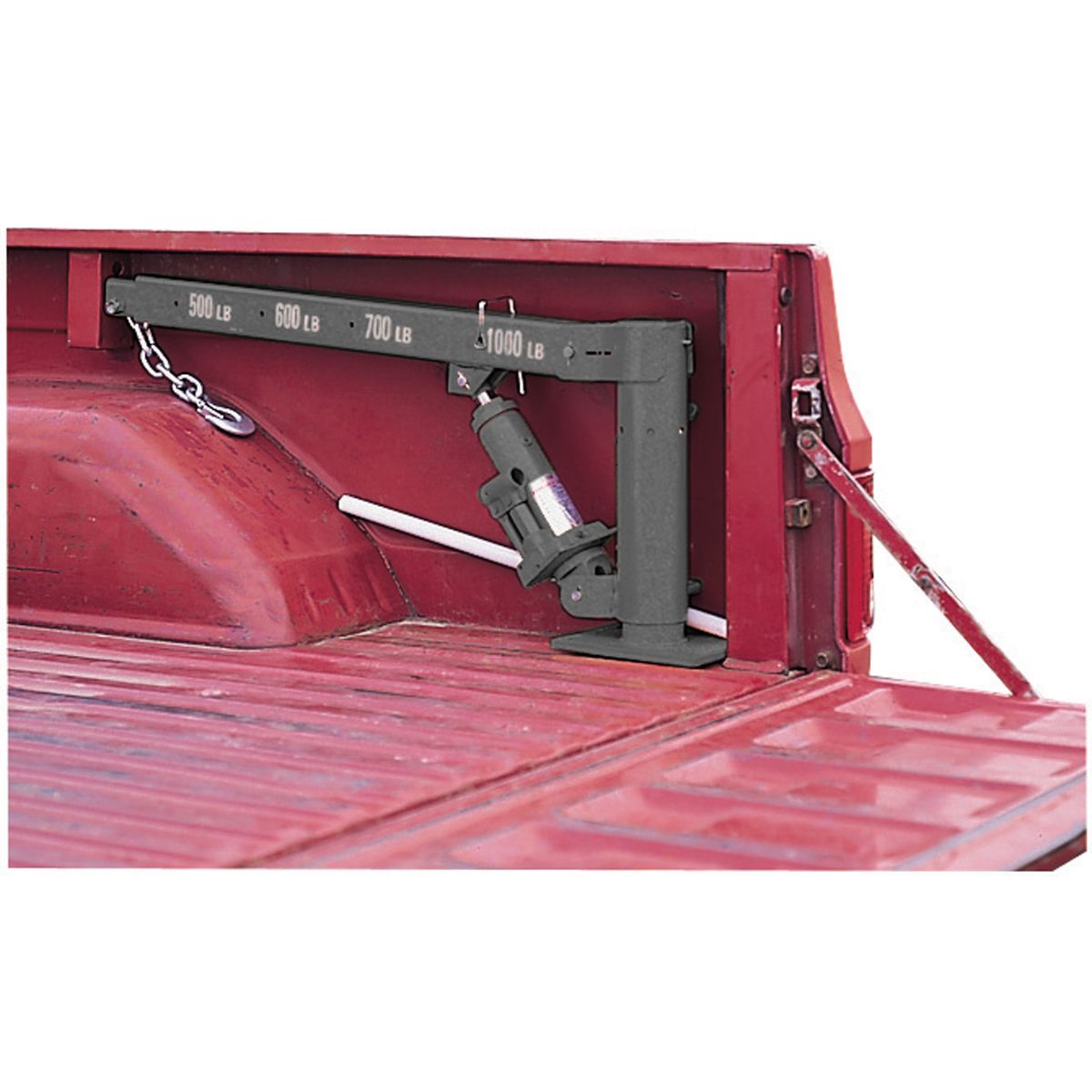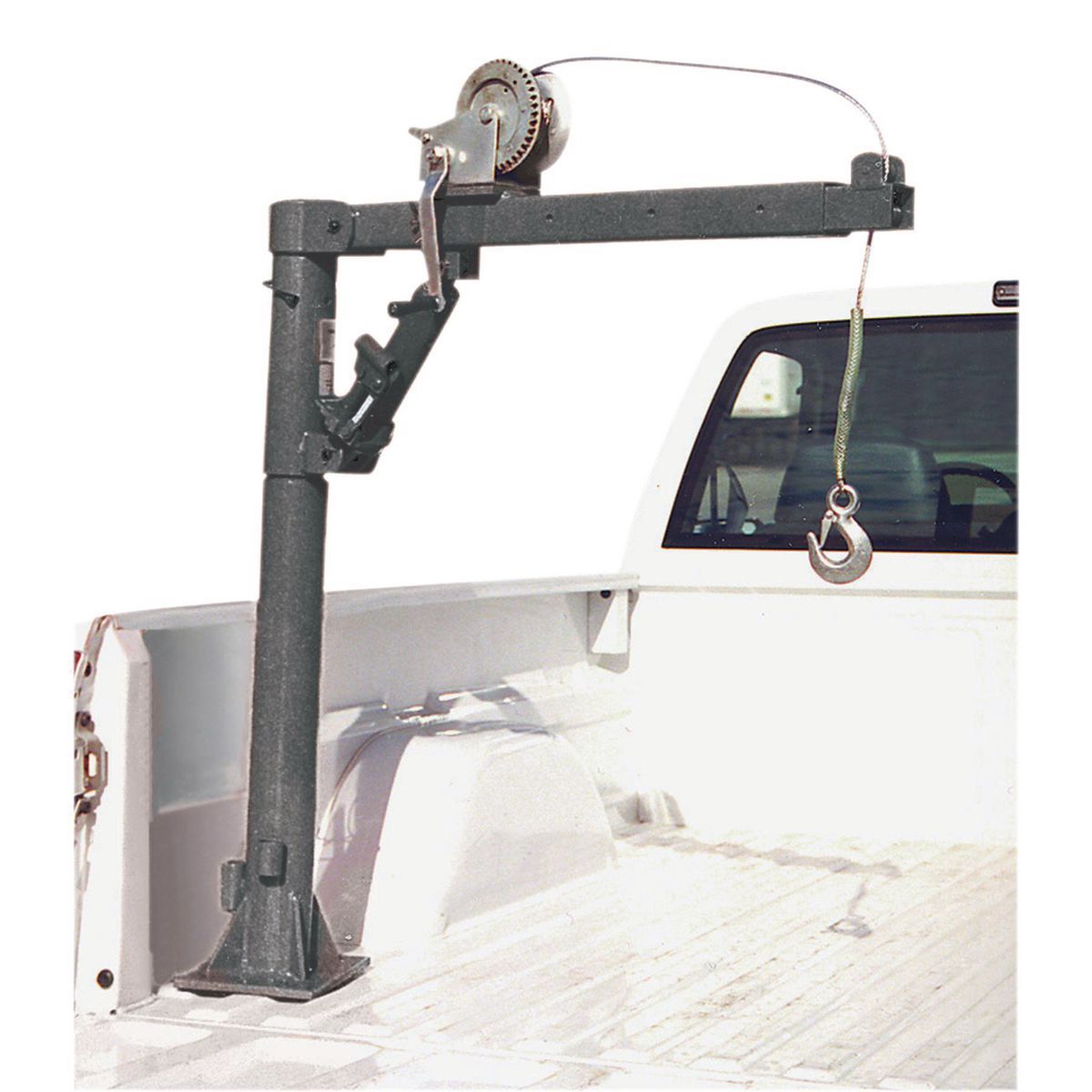-
Welcome back Guest! Did you know you can mentor other members here at H-M? If not, please check out our Relaunch of Hobby Machinist Mentoring Program!
You are using an out of date browser. It may not display this or other websites correctly.
You should upgrade or use an alternative browser.
You should upgrade or use an alternative browser.
Lifting Heavy Lathe Chucks
- Thread starter erikmannie
- Start date
- Joined
- Nov 14, 2016
- Messages
- 2,994
Here's my (slightly modified) Harbor Freight truck bed crane.
It came with a hand pumped hydraulic cylinder, rated at 1000 lbs (I lifted my 700 lb. Kalamazoo saw and left it hanging overnight) and costs less than $120. Make your own post and you're in business.

1/2 Ton Capacity Pickup Truck Bed Crane
Amazing deals on this 1/2Ton Capacity Pickup Truck Crane at Harbor Freight. Quality tools & low prices.www.harborfreight.com
This one comes with a winch

1/2 Ton Capacity Pickup Truck Bed Crane with Hand Winch
Amazing deals on this 1/2Ton Capacity Pickup Truck Crane at Harbor Freight. Quality tools & low prices.www.harborfreight.com
Are you actually using one on your truck, or have you rigged up a way to use it in the shop?
- Joined
- Jan 20, 2018
- Messages
- 5,613
It's primary use is for loading firewood rounds into the truck. So far I haven't had to deal with anything heavy (besides the machines) in my shop. With the snowplow pump, the lifting capacity is only about 350 lbs. If I need it in the shop, I'll just buy another.Are you actually using one on your truck, or have you rigged up a way to use it in the shop?
- Joined
- Jul 29, 2014
- Messages
- 2,725
The HF engine hoist has been pretty useful for these kinds of things. I’ve lifted the 2500 pound Takisawa and positioned it, lifted the motorcycle for misc. work, put the hoist in the truck, drove to big logs, assembled the hoist on the ground near the logs (they were already on a paved area) lifted and backed the truck under. Easy. I also use it to unload heavy goodies from the truck back at home.
Adding a hoist to the truck bed sounds good but it looks scary hard to me.
Adding a hoist to the truck bed sounds good but it looks scary hard to me.
- Joined
- Jan 2, 2019
- Messages
- 6,484
That was actually the first thing that came to mind for me, if you can't attach a rail for a gantry above your lathe the Harbor Freight engine hoist would surely do the job easily. Also multi-purpose as @Winegrower pointed out.
John
John
In my case one of these
 was repurposed as a chuck rail over my lathe. It is mounted horizontally on the ceiling joists.
was repurposed as a chuck rail over my lathe. It is mounted horizontally on the ceiling joists.
A small boat winch was adapted for lifting. It allows me to hoist the chuck up over the rear chip guard. I only have one heavy chuck so it hangs on the hook behind the lathe until needed again. The other chuck is light enough to handle by hand.
This 'system' was cobbled together with surplus stuff I had on hand and looks weird but it works very well.

A small boat winch was adapted for lifting. It allows me to hoist the chuck up over the rear chip guard. I only have one heavy chuck so it hangs on the hook behind the lathe until needed again. The other chuck is light enough to handle by hand.
This 'system' was cobbled together with surplus stuff I had on hand and looks weird but it works very well.
- Joined
- Feb 9, 2017
- Messages
- 5,228
I feel like 6” 4jw is about all I want to mess with in the awkward position of mounting in the lathe by hand.
I have a HF engine hoist, 1,000 lift cart, and 1tn chain hoist. Between the three I feel like I’ve got everything covered. The problem with the engine hoist is getting the legs under what you need to lift. That’s why I got the chain hoist to lift my 10” rotary table on to my mill. That has got to be around 130#’s and I could weasel it with the lift table but it didn’t feel safe.
I got a HF 1tn chain hoist when i was doing a huge fab project and it worked wonderfully because it can work in any position and it’s small enough to be able to hook onto rafters and has a very long lift range. One of the first things we used it for along with 3 others was lifting 6,000# sizer 110” into the air. They worked perfect and ended up being handy for all kinds of uses. At around $70 they are a bargain. For lifting my RT I have it braced between two rafters and close to a side wall. I‘d not use it further away from the wall without legs to the floor depending on how heavy we’re talking about.
I have a HF engine hoist, 1,000 lift cart, and 1tn chain hoist. Between the three I feel like I’ve got everything covered. The problem with the engine hoist is getting the legs under what you need to lift. That’s why I got the chain hoist to lift my 10” rotary table on to my mill. That has got to be around 130#’s and I could weasel it with the lift table but it didn’t feel safe.
I got a HF 1tn chain hoist when i was doing a huge fab project and it worked wonderfully because it can work in any position and it’s small enough to be able to hook onto rafters and has a very long lift range. One of the first things we used it for along with 3 others was lifting 6,000# sizer 110” into the air. They worked perfect and ended up being handy for all kinds of uses. At around $70 they are a bargain. For lifting my RT I have it braced between two rafters and close to a side wall. I‘d not use it further away from the wall without legs to the floor depending on how heavy we’re talking about.
- Joined
- Aug 5, 2013
- Messages
- 251
Something I posted last year.. works for me: https://www.hobby-machinist.com/thr...uck-lifting-moving-storage.83161/#post-729659
- Joined
- Feb 13, 2017
- Messages
- 2,138
At what point (i.e. chuck weight) does one need a hoist or chain fall to install a heavy chuck?
I just bought a chuck that weighs 107 lbs. I would not expect to be able to get that on & off without a hoist such as this:
At the time (1982ish) I was working "Civil Service" as an electrician at a Naval Station, there was a limit of 35 pounds on what could be lifted. (??Navy or OSHA??) My electrician's pouch was nearer 40 pounds so the "rule" was usually ignored. In my own shop, there are days that I am willing to try 200 pounds and there are days that 10 pounds is too heavy.
I have acquired a "wheelchair lift" (cheap) that is almost identical to an engine hoist, just half the size and shiney. On the days I feel weak, the hoist can be dug out. If I'm just lazy that day, the time to dig out the hoist isn't worth the trouble, I just pick it up (using proper lifting techniques) and go. Sometimes, if I think I'll need to shift my grip, I'll hang a tie down strap from the ceiling joist as back-up. Such as mounting the Atlas Milling Machine on a stand. . . I use a 12X36 inch Atlas lathe. The heaviest chuck I have is a 10 inch 4 jaw. I have no idea what it weighs, just that some days I don't feel like wrestling with it.
Working around a precision machine such as a lathe, I would want at least a back-up for any heavy (over~10#) part that could drop and damage the ways. That's why there is a piece of plywood kept handy. The plywood is always in place on the bed of the machine, even if I'm mounting the 3 inch chuck. The MT-3 adapter for it is heavier than the chuck. . .
I'm 70 now, I'm haven't been 31 for a long time. For anything heavier than I am capable of handling, I would use the hoist. I say handling vs lifting intentionally. Lifting is just part of the process. Handling, or controlling, what is lifted is much more important. I don't think the hoist pictured would be the most useful. But every person is individual and every person's capacity changes day to day. I use a wheelchair lift because it has shorter "legs" than an engine hoist. But then. I have floor space to handle it. If nothing more than a motorcycle tie down over the joists, anything is useful. Even my "mill shoes" wouldn't be much help if I dropped the 4 jaw.
.

